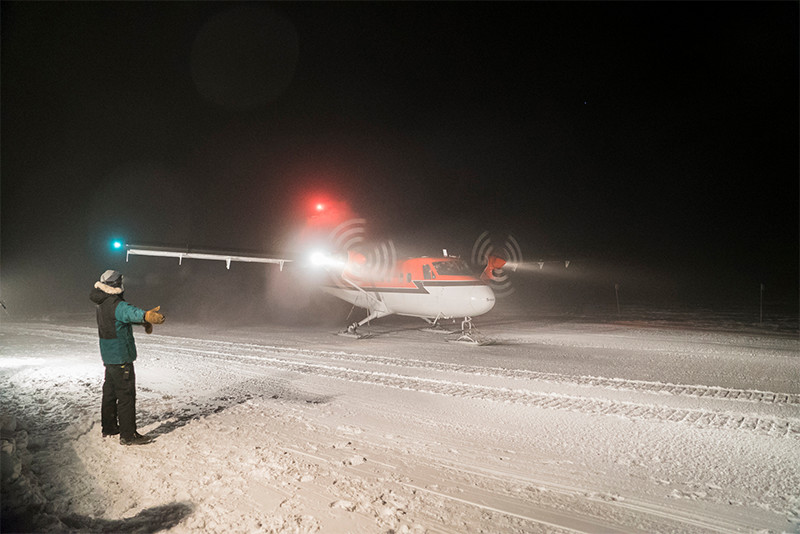|
Division of Polar Programs South Pole Medical Evacuation Mission Concludes Safely
A Twin Otter aircraft on a medical evacuation flight taxis on the skiway at NSF's Amundsen-Scott South Pole Station. (Image Credit: Robert Schwarz, National Science Foundation) Updated June 23, 2016 Two people stationed at the National Science Foundation’s (NSF) Amundsen-Scott South Pole Station have arrived safely in Punta Arenas, Chile, for medical treatment. The arrival completes a nine-day, global evacuation operation that NSF coordinated to prioritize the health and safety of station and rescue personnel. For additional information on the mission's conclusion, please see this NSF news release. For background on the evacuation mission, see the previous news releases linked below. Updated June 22, 2016 Twin Otter carrying two patients left South Pole early this morning For additional information regarding the overall mission, please see this NSF news release. Updated June 21, 2016 An Antarctic medical-evacuation flight has arrived at the National Science Foundation’s Amundsen-Scott South Pole Station. The plane will now remain at the Pole for roughly 10 hours to allow the aircrew to rest. The crew will then assess weather conditions at both Pole and the British Antarctic Survey’s Rothera Station before flying back to Rothera. The plane left Rothera early this morning for the flight to the Pole. Additional updates will follow as warranted. For more background information, please read the previous NSF news releases below. Updated June 21, 2016 
A medical-evacuation flight to the South Pole left the British Antarctic Survey’s Rothera Station early this morning (local time) and is on the way to the National Science Foundation’s Amundsen-Scott South Pole Station. The Kenn Borek Air Twin Otter is expected to arrive at the station at approximately 5PM Eastern Standard Time. The aircrew took advantage of a favorable weather window to leave at approximately 8AM on June 21. Additional updates will follow as warranted. For more background information, please read the previous NSF news releases below. Updated June 20, 2016 Two Twin Otter aircraft flying an Antarctic medical-evacuation mission have arrived at Rothera, a British Antarctic Survey station on the Antarctic Peninsula, where they will now await favorable weather to fly the roughly 1,500 miles to the National Science Foundation's Amundsen-Scott South Pole Station. At Rothera, the aircrews will prepare the aircraft, including equipping them with skis for a landing on snow and ice at the pole. Once the forecast is favorable, one plane will fly to the pole to evacuate an ailing member of the station's winter crew, the other will remain at Rothera to provide search-and-rescue capability, as needed. It is possible that the evacuation flight will bring a second patient out of Antarctica. That decision still is pending. After comprehensive consultation with outside medical professionals, agency officials previously decided that a medical situation at Amundsen-Scott warrants returning one member of the station's winter crew to a hospital that can provide a level of medical care that is unavailable at the station. That patient is seasonally employed through the Lockheed Martin Antarctic Support Contract, the prime contract for operations and research support contractor to NSF for the United States Antarctic Program (USAP). NSF is not releasing any further personal or medical information to preserve patient privacy. For more background information, please read the previous NSF news releases below. Updated June 19, 2016 The two aircraft en route to the National Science Foundation's Amundsen-Scott South Pole Station to carry out an Antarctic medical evacuation are on the ground in Punta Arenas, Chile. They are awaiting favorable weather to fly to the British Antarctic Survey Station at Rothera, where they will prepare the aircraft and await favorable weather to make the flight to the Pole. For background information about the overall mission, please see this NSF news release: https://www.nsf.gov/news/news_summ.jsp?cntn_id=138914 Posted June 14, 2016 Officials with the National Science Foundation (NSF) have launched a medical evacuation flight to NSF's scientific station at the geographic South Pole. After comprehensive consultation with outside medical professionals, agency officials decided that a medical situation at Amundsen-Scott South Pole Station warrants returning a member of the station's winter crew to a hospital that can provide a level of medical care that is unavailable at the station. See the full text of the National Science Foundation press release at the NSF site. National Science Foundation |



For USAP Participants |
For The Public |
For Researchers and EducatorsContact UsNational Science FoundationOffice of Polar Programs Geosciences Directorate 2415 Eisenhower Avenue, Suite W7100 Alexandria, VA 22314 Sign up for the NSF Office of Polar Programs newsletter and events. Feedback Form |

